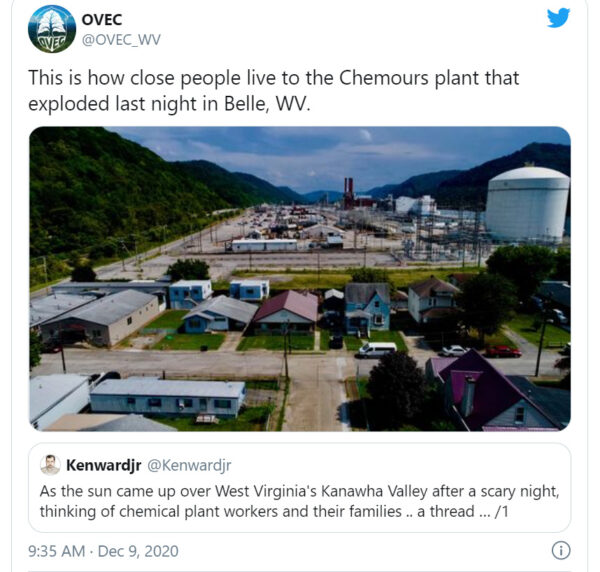
The West Virginia Department of Environmental Protection (DEP) issued a statement after the Optima Chemical December 8, 2020 explosion at the Chemours facility in Belle, WV, saying that their data indicated no exceedances of the federal national ambient air quality standards during or in the hours following the explosion. From that statement and the use of big words by outgoing DEP Cabinet Secretary, Austin Caperton, it would be easy for residents living near the plant to think DEP did their due diligence in protecting them from possible exposure from anything that might have been released in the explosion. However, it doesn’t take much looking to figure out their statement just really doesn’t make sense.
Here are just a few reasons why.
First, there is an issue with the location where they got their data. DEP collected data from their NCore air monitoring site located at 1436 Dixie St., Charleston, approximately eight miles, as the crow flies, northwest of the site of the explosion in Belle. This monitor is nowhere near the communities of Rand, Belle, Marmet, and Chesapeake that were closest to the incident. That means any pollutants would have had to travel that far to be detected, and possibly would have been dispersed/diluted before reaching the monitor in Charleston.
Additionally, several weather data sites, such as Weather Underground, indicate that wind was mostly moving from the south toward the north/northeast between 9 p.m. and midnight on Tuesday, December 8, the day of the explosion. The air monitor in Charleston—again, 8 miles away—is northwest of Optima Belle. This means the air at the time of the incident was moving in the opposite direction. So, how could DEP’s monitor have picked up any data?

Meteorological data provided by the Environmental Health Project indicates that weather patterns on the day of the explosion caused a plume of contaminants to disperse northeast of Charleston, WV. The DEP air monitoring site in Charleston did not register these pollutants.
Even if the distant monitor did pick up data from the explosion, there are other factors at play here. WVU Professor Dr. Michael McCawley notes the location of the plant in question and the surrounding community is at the bottom of a river valley. These valleys, and the local weather that happens because of them, can typically limit the dilution of any chemicals discharged into the air. This means the nearby area would be most impacted, rendering the data from Dixie St. in Charleston relatively useless.
Also, according to sources at the DEP, there was no real-time monitoring on site during the explosion. Therefore, there is no real data to determine how much chemicals escaped into the air and how much they may have impacted the immediate surrounding areas. While it is true some of it may have burned off in the fire, we don’t know for certain how much without real-time monitoring. It’s bad enough current laws do not require any fenceline monitoring at chemical facilities to begin with, but to take no sampling during the explosion and expect to have accurate data is ridiculous.
Finally, the Clean Air Act requires the U.S. Environmental Protection Agency to set National Ambient Air Quality Standards (NAAQS) for six common air pollutants: carbon monoxide, lead, ground-level ozone, nitrogen dioxide, particulate matter, and sulfur dioxide. These standards exclude many other kinds of emissions that could negatively impact outdoor air quality near the site. Just because DEP uses data from the air monitoring site to claim there were supposedly no exceedances of the federal air quality standards during or in the hours following the explosion, that does not mean air quality wasn’t impacted for nearby residents. DEP’s monitor would have never picked up traces of methanol or CDB 63 because it is not designed to detect them. Just methanol alone is toxic, but if CDB 63 disperses into the air where it can contact moisture, it can react with water to form extremely toxic chlorine gas. But what you don’t test for can hurt you, right?
These reasons alone are enough to poke holes in DEP’s statement. Fact is, it’s obvious DEP has no clue if air quality was impacted by the explosion.
Why did it take so long for the DEP to gather their “data” to make a statement to begin with? The statement came out two days after the explosion. Do citizens not deserve immediate answers to what might impact them when companies get careless?
Horrifyingly, the explosion also killed one plant worker and sent several others to the hospital. The families of those killed and injured, and the rest of us living in the Chemical Valley deserve better from the DEP. At the very least we can demand that the DEP stop giving the public just a bunch of hot air.












